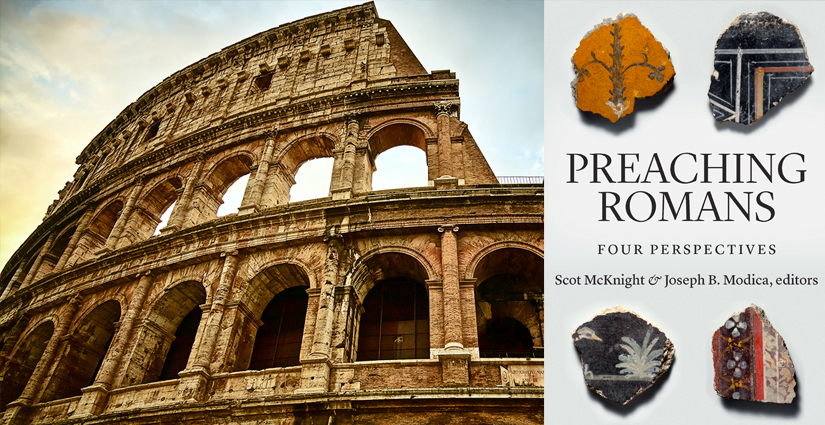Even though I’ve never been in the “Reformed” theological camp, I did once regularly attend a church that was part of the “Sovereign Grace” denomination. [1] What initially attracted me to that church, despite its very foreign tradition, was the intense way the lead pastor was teaching through the book of Romans. As far as I can recall, it’s the first and only church I’ve attended that did a very deliberate, chapter-by-chapter study of Romans. The Pentecostal tradition through which I’d entered the Christian faith didn’t treat theology with such passion nor importance. In fact, in my particular church circles there was a virulent strain of anti-intellectualism I chafed against. But, in the few months I sat under the teaching of that church and its pastor, I learned that Romans could be viewed through a prism of systematic theology which entirely constrains and contorts its meaning. I was amazed at how the pastor used Romans chapters 9-11 to talk about individual predestination to salvation rather than Israel and the gentiles. I was amazed by how he somehow shoehorned Romans 10.14 into a Calvinistic theological framework.
That season was the genesis of my interest in the interpretation of Romans. Since then, and for the past sixteen years or so, I’ve been fascinated by all the exciting new perspectives that are being debated in the academy. I remember when I was attending a Baptist church (another foreign tradition) and the pastor was best friends with a Gordon-Conwell professor. The pastor told me in hushed tones about how his friend had his New Testament courses taken away from him because the school disapproved of him teaching “The New Perspective on Paul.” (This was over ten years ago). This didn’t surprise me at all since I’d graduated from Gordon-Conwell and could still recall the lectures in which professors accused N. T. Wright of teaching Pelagianism and “works righteousness.”
I can also recall the first AAR (American Academy of Religion) conference at which I presented a paper in the Open and Relational Theologies Unit. That year, Wright had a very public debate with Douglas Campbell near the release of his very large volume, The Deliverance of God. I confess I didn’t understand everything they were talking about, but I did accidentally sit directly behind Richard Hays, and his running commentary throughout was hilarious.
So, in the last sixteen years or so, I’ve been extremely curious about the development of theology related to Romans. However, as a pastor in the local church, I haven’t seen a lot of opportunities to teach what I’ve learned, nor seen many resources on Romans geared toward ministry practitioners. That is why Preaching Romans caught my attention immediately.
Book Structure
Preaching Romans: Four Perspectives gives several of the leading proponents of four of the most popular interpretative frameworks of Romans an opportunity to present their views and how they would implement them through the medium of a sermon. The book does this by starting out with four essays, one on each of the four interpretive frameworks. Then it gives three preachers the opportunity to explicate that view through a sermon. Four theological essays, twelve sermons. Here’s the line up of theologians and preachers:Essays:
- Romans and the “Lutheran” Paul - Stephen Westerholm
- Romans and the New Perspective - Scot McKnight
- Romans and the Apocalyptic Reading of Paul - Douglas Campbell
- Romans and the Participationist Perspective - Michael J. Gorman
Sermons:
“Reformational Perspective” Sermons:- Romans as Ecclesial Theology: Building Multiethnic Missional Churches - Michael Bird
- God Justifies the Ungodly: Romans 4:1-8 - Thomas Schreiner
- The Transforming Reality of Justification by Faith: Romans 5:1-5 - Carl Trueman
- The Balance of Already/Not Yet: Romans 8:1-17 - James Dunn
- This Changes Everything: Romans 5:12-21 - Tara Beth Leach
- Pass the Peace by Faith: Romans 4:1-4, 13-17 - Scot McKnight
- Immortal Combat: Romans 1:16-17 and 5:12-14 - Jason Micheli
- In Celebration of Full Communion: Romans 3:21-24 - Fleming Rutledge
- Old Adam, New Adam; Old World, New World; Old You, New You: Romans 5:12-21 - William Willimon
- Death Becomes Her: Romans 6:1-14 - Timothy Gombis
- Made New by One Man’s Obedience: Romans 5:12-19 - Richard Hays
- Breathing Well: Romans 8:12-30 - Suzzanne Watts Henderson
Praise
I’ve long appreciated the multi-perspectives format, like Zondervan’s “Counterpoints” series. Having some of the leading proponents of popular views present them side-by-side highlights their differences in stark contrast. You not only learn a lot about the views you know least about, you also learn some new things about the views you know well. Two of the interpretive framework essays were excellent, two were somewhere between disappointing and predictably-irritating. The two excellent ones were Scot McKnight’s and Michael Gorman’s.McKnight and the New Perspective
Right off the bat, McKnight puts his finger directly on one of the most important differences between the New Perspective/Participationist frameworks and the Lutheran/Apocalyptic: social justice.“When I watch white nationalists trumpeting their hatred, when I read of racial violence against black men in Chicago by law enforcement, when I observe low-paying, hard-working jobs performed by Latin Americans, when I hear stories about Northern Ireland and the Republic of Ireland, when I study the genocide of Rwanda, and you can add your own systemic injustices against groups of people, I am grateful for what the new perspective brings to the preacher of Romans.” (20)Individualism is a crucial aspect of the “Lutheran” and “Apocalyptic” perspectives, while the “New” and “Participationist” perspectives capture far more of the collectivist cultural thrust of Paul’s worldview and the letter to the church in Rome in particular.
“…the people of God that expands Israel into a worldwide community of Jews and gentiles; the locus of that participation is the church, the ekklesia, of Jesus that gathers to worship God in Christ and to indwell one another in fellowship through the Spirit, and that engages in mission in this world in a Christoform (or cruciform) life for both individuals and the ekklesia.” (21)Another crucial distinction between the two major camps—Lutheran and Apocalyptic on the one side, New and Participationist on the other—is their starkly contrasting views of Judaism. E. P. Sanders brought about a Copernican Revolution in how Judaism is viewed in the midst of interpreting Romans with his monumental work: Paul and Palestinian Judaism (1977). But those who hold the Lutheran and Apocalyptic frameworks still live in a geocentric (i.e. works righteousness-centered worldview). They still consider Paul’s main foe in Romans to be the human desire to “earn salvation” through a practice of legalistic rule-following, typified by Judaism. They consider “grace” to be the opposite of such an evil impulse, the remedy requiring nothing more than intellectually assenting to a proposition about a new legal status before God granted by Christ’s propitiation of an otherwise wrathful and litigious deity.
“One still encounters this pre-Sanders theory of Judaism in sermons in which we hear that humans are by nature works-shaped or seeking to earn favor with God, or which pose religion (read: Judaism) against grace. My point is not that humans aren’t egocentric but that such a view is often unconsciously (or at times even consciously) rooted in a way of framing Judaism itself, the foil of the gospel of grace in Paul.” (22)McKnight’s summary of N. T. Wright’s contribution was particularly well done. The umbrella of reconciliation under which Wright draws together so many of the variations and nuances of the New Perspective (there are several different “new perspectives”) is inspiring.
“Wright’s landing spot for Pauline theology’s on-the-ground reality is nothing less than the preacher’s platform: reconciliation. Wright’s redemptive, ecclesial, creational reality for the believer is this: God has reconciled all things in Christ; the believer is reconciled in Christ; believers are reconciled to one another; the Christian is an agent of reconciliation in the world; the kingdom is new creation fully reconciled.” (28)Of all the perspectives, McKnight’s approach of reading Romans “backwards,” as it were, in light of the on-the-ground reality of house churches filled with Jesus-disciples who are learning how to be a new humanity together, coming from very different social locations, was the most helpful for local church preachers. This is theology that preaches to congregations.
“Paul is a pastor thinking of local house churches where the Strong are to open the doors and welcome (to the table) the Weak, and thereby create a fellowship of siblings.” (31)McKnight’s essay was educational, practical, and inspirational. After reading his essay, a preacher could easily craft a rich and exciting teaching series that would no doubt bear much fruit among any congregation.
Gorman and the Participationist Perspective
The other excellent essay was the Participationist. Gorman’s view is closely related, if not overlapping, with the New Perspective. To start he states,“Perhaps the central practical issue Paul addresses in Romans is ‘What does it mean to be a diverse community of gentiles and Jews who have believed this gospel of the crucified and resurrected Messiah and been baptized into him?’” (64)This central concern of the unity of the church among diverse cultures is precisely what the New Perspective has brought into the spotlight. Gorman’s Participationist perspective also reconciles the debate over the “imputation” versus “impartation” of Christ’s righteousness:
“Jews and early Christians understood the Messiah to embody the righteousness of God, the natural implication would be that those ‘in’ the Messiah would do so too.” (64) “…justification itself is more than a divine acquittal, for participation involves transformation […] justification is certainly not a ‘legal fiction,’ or even simply a change in status; it is the beginning of participating in a new reality—a new creation (2 Cor. 5:17; Gal. 6:15).” (68)This shows the contrast between the New Perspective and Participationist views from the Lutheran and Apocalyptic. Both New Perspective and Participationist bring together justification and sanctification while broadening the location of salvation to the corporate and collective context, while the Lutheran and Apocalyptic perspectives divorce justification from sanctification and tighten the scope of salvation to the individual.
“To be in Christ is to be together with siblings, in community, and to participate in the fellowship of the Spirit as the one body of Christ (1 Cor. 12; Phil. 2:1-4).” (74)Like the New Perspective model, the Participationist model naturally leads to an emphasis on social justice as an integral aspect of the Gospel and essential on-the-ground reality:
“But what specifically does such a Spirit-infused, multicultural worshiping community look like? Fundamentally, it will be Christlike, and specifically cruciform, for each individual and the church as a whole has been co-crucified with Christ and co-raised with him to new life in the Spirit, a life marked by the pattern of cross and resurrection, as we saw in chapter 8. This will be a community of obedient faithfulness issuing in generous love and expectant hope. Such a community will demonstrate a preferential option for the weak and will accept cultural differences about diet and other matters that do not ultimately matter (14:1-15:13).” (77)My one criticism of Gorman’s essay was his attempt to soften the distinctiveness of the Participationist framework by saying it could be incorporated into any of the other three. I think this undervalues its unique contribution. One of the Participationist approach’s strengths is its unification of justification and sanctification, which cuts against the “legal fiction” of imputed righteousness. Another one of its strengths is its natural emphasis on the Spirit. None of the other three views have as strong of a pneumatology as the Participationist framework. But, that aside, the Participationist perspective was the one that I found most compelling. Coupled with the New Perspective, these two interpretive frameworks give Romans powerfully practical and transformative preaching potential. As for sermons, the five best were by: Micheal Bird, Tara Beth Leach, Scot McKnight, Richard Hays, and Suzanne Watts Henderson.
Criticism
I won’t waste much time on the “Lutheran” view, because I’m obviously biased. If you’re familiar at all with my other writing, you’ll know that I flatly reject Calvinism, especially in its most obnoxious, Neo-Puritan forms. The Lutheran view is an outmoded perspective. It’s been eclipsed by the other three. And yet it’s probably still the most common among “Evangelical” preachers. The bottom line of its error is that it refuses to interpret Paul within the context of his first-century Judaism. Though this criticism has been around for close to half a century, “Reformed” preachers continue to plug their ears and regurgitate the latest thing they’ve heard Tim Keller or John Piper preach. It’s pitiful really. And the essay and sermons from this perspective were hard to read for all these reasons. But, what was most surprising to me was how little new the Apocalyptic perspective had to say. From the hype one hears in academic theological circles, you’d think it was some kind of revolutionary new idea. It’s not. The Apocalyptic view hangs on the same Monergistic, Cheap Grace that the Lutheran view pioneered. Only it does so with far more pompous rhetoric. God doesn’t merely assign you a new legal status, God does so as an act of “liberation from the Powers.” Regardless, this unilateral theory undermines the ubiquitous synergistic language in Romans which the New Perspective and Participationist perspectives highlight. The Apocalyptic view might correctly discern that Paul viewed “Sin” and “Death” as cosmic powers, but it incorrectly discerns how God deals with them. God does not act as a colonizing force with no regard for the native life. No! God is essentially relational, the Triune God who is Father, Son, and Holy Spirit. God ‘works together’ with human beings, as Paul teaches (cf. Romans 8.28). Finally, there were several sermons that seemed to be mis-categorized. Michael Bird’s sermon was listed among the “Reformational” sermons, but it didn’t have a hint of imputed righteousness nor screeds against “works righteousness.” Instead it focused on the bringing together of gentiles and Jews and the creation of a new messianic, multiethnic, and missional community. He even very specifically distinguishes his view from the core aspects of the other “Lutheran” sermons:“I want to suggest to you that Romans has a different purpose and a different application, beyond an artificially constructed neo-Puritan and hyper-individualist account of salvation, something far more profound to my mind. I submit to you that Romans is really about creating a messianic missional community where, despite painful differences and manifold diversities, there is a reciprocal acceptance of one another and a shared commitment to unity.” (86)Amen! I couldn’t agree with Bird more on this point. I’m not sure what gets Bird’s sermon placed along side Schreiner and Truman’s sermons, which explicitly reflect the neo-Puritanism and hyper-individualism Bird disavows. Meanwhile, Will Willimon’s sermon was categorized among the Apocalyptic sermons, but really contains nothing that could distinguish it from a run-of-the-mill Lutheran sermon. And this from a Methodist!
“Here’s Paul’s gospel in a nutshell: In Christ, God has decisively, once and for all, done something about our sinful, death-dealing servitude.” (144)Has no one given Willimon a copy of The King Jesus Gospel nor Simply Good News nor Salvation by Allegiance Alone? For a prominent Methodist leader to so drastically misunderstand Paul’s Gospel is tragic.
Conclusion and Recommendation
Preaching Romans is a great resource for preachers who would like to have the complexities of decades of academic debates over things like justification and predestination boiled down in four clear presentations. It’s also excellent at demonstrating how these views show up in sermons, and the way sermons from alternative perspectives contrast. Preaching Romans isn’t likely to sway readers away from their current interpretive framework. Like other competitive spaces where strongly held beliefs are challenged, people are more likely to double down on their pre-existing biases. Nevertheless, it is good to learn how some of the most popular and respected proponents of alternative views would communicate their own position. I highly recommend Preaching Romans not only for preachers but for all those who are theologically curious.- For those who aren’t familiar (good for you!), the “Sovereign Grace” denomination is a Neo-Puritan (Calvinist) and Neo-Charismatic group. They’re what you get when you cross John Piper’s theology and the Vineyard. It was co-founded by C. J. Mahaney, a pastor who later resigned amidst a sexual abuse scandal. Here’s a break down: https://www.washingtonpost.com/local/lawsuit-accuses-neo-calvinist-church-movement-leaders-of-child-sexual-abuse/


